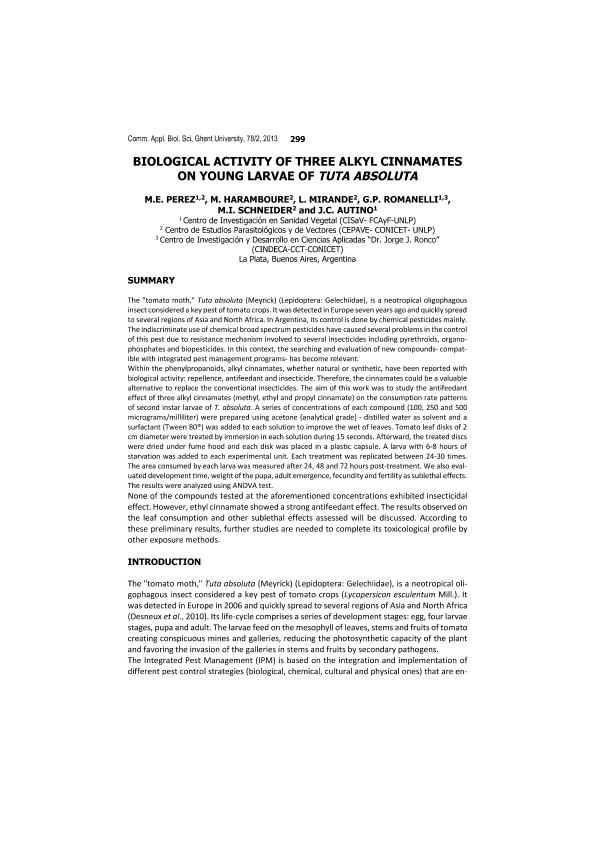Artículo
Biological activity of three Alkyl Cinnamates on young larvae of Tuta Absoluta
Pérez, María Emilia ; Haramboure, Marina
; Haramboure, Marina ; Mirande, Luciana
; Mirande, Luciana ; Romanelli, Gustavo Pablo
; Romanelli, Gustavo Pablo ; Schneider, Marcela Inés
; Schneider, Marcela Inés ; Autino, Juan Carlos
; Autino, Juan Carlos
 ; Haramboure, Marina
; Haramboure, Marina ; Mirande, Luciana
; Mirande, Luciana ; Romanelli, Gustavo Pablo
; Romanelli, Gustavo Pablo ; Schneider, Marcela Inés
; Schneider, Marcela Inés ; Autino, Juan Carlos
; Autino, Juan Carlos
Fecha de publicación:
12/2013
Editorial:
Universiteit Ghent
Revista:
Communications in Agricultural and Applied Biological Science
ISSN:
1379-1176
Idioma:
Inglés
Tipo de recurso:
Artículo publicado
Clasificación temática:
Resumen
The "tomato moth," Tuta absoluta (Meyrick) (Lepidoptera: Gelechiidae), is a neotropical oligophagous insect considered a key pest of tomato crops. It was detected in Europe seven years ago and quickly spread to several regions of Asia and North Africa. In Argentina, its control is done by chemical pesticides mainly. The indiscriminate use of chemical broad spectrum pesticides have caused several problems in the control of this pest due to resistance mechanism involved to several insecticides including pyrethroids, organophosphates and biopesticides. In this context, the searching and evaluation of new compounds- compatible with integrated pest management programs- has become relevant. Within the phenylpropanoids, alkyl cinnamates, whether natural or synthetic, have been reported with biological activity: repellence, antifeedant and insecticide. Therefore, the cinnamates could be a valuable alternative to replace the conventional insecticides. The aim of this work was to study the antifeedant effect of three alkyl cinnamates (methyl, ethyl and propyl cinnamate) on the consumption rate patterns of second instar larvae of T. absoluta. A series of concentrations of each compound (100, 250 and 500 micrograms/milliliter) were prepared using acetone (analytical grade) - distilled water as solvent and a surfactant (Tween 80®) was added to each solution to improve the wet of leaves. Tomato leaf disks of 2 cm diameter were treated by immersion in each solution during 15 seconds. Afterward, the treated discs were dried under fume hood and each disk was placed in a plastic capsule. A larva with 6-8 hours of starvation was added to each experimental unit. Each treatment was replicated between 24-30 times. The area consumed by each larva was measured after 24, 48 and 72 hours post-treatment. We also evaluated development time, weight of the pupa, adult emergence, fecundity and fertility as sublethal effects. The results were analyzed using ANOVA test. None of the compounds tested at the aforementioned concentrations exhibited insecticidal effect. However, ethyl cinnamate showed a strong antifeedant effect. The results observed on the leaf consumption and other sublethal effects assessed will be discussed. According to these preliminary results, further studies are needed to complete its toxicological profile by other exposure methods.
Palabras clave:
Tuta Absoluta
,
Alkyl Cinnamates
,
Toxicity
,
Biological Activity
Archivos asociados
Licencia
Identificadores
Colecciones
Articulos(CEPAVE)
Articulos de CENTRO DE EST.PARASITOL.Y DE VECTORES (I)
Articulos de CENTRO DE EST.PARASITOL.Y DE VECTORES (I)
Citación
Pérez, María Emilia; Haramboure, Marina; Mirande, Luciana; Romanelli, Gustavo Pablo; Schneider, Marcela Inés; et al.; Biological activity of three Alkyl Cinnamates on young larvae of Tuta Absoluta; Universiteit Ghent; Communications in Agricultural and Applied Biological Science; 78; 2; 12-2013; 299-304
Compartir



